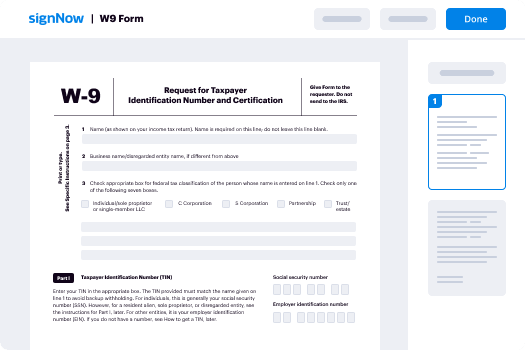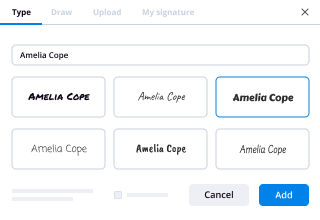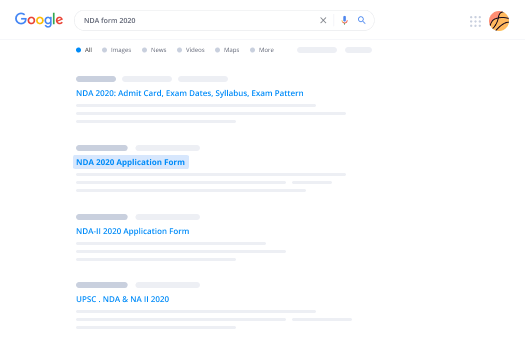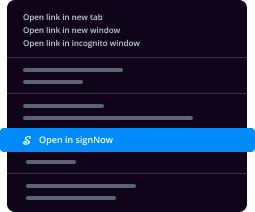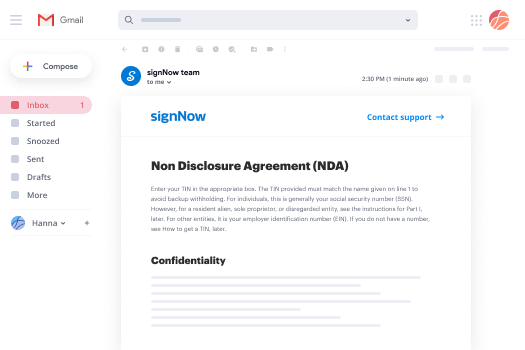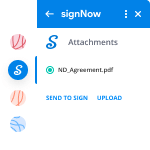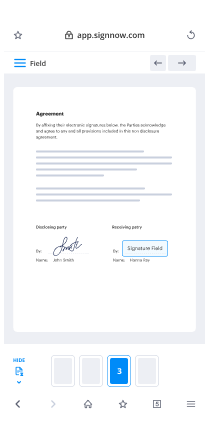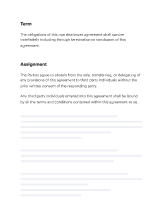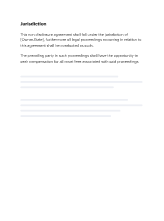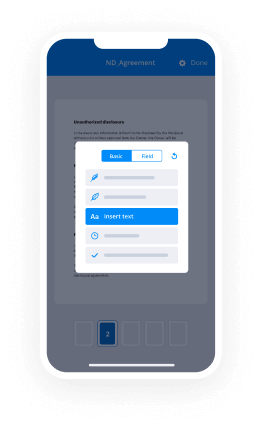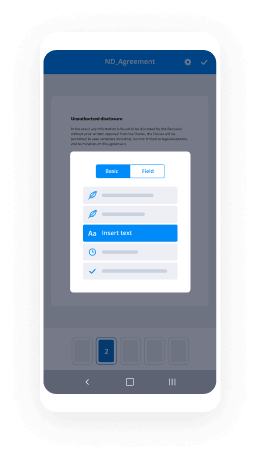Profitez De Flux De Travail eSignature Flexibles : Ce Qui Rend Un Document Juridiquement Contraignant
- Démarrage rapide
- Facile à utiliser
- Support 24/7
Les entreprises qui pensent à l'avance dans le monde entier font confiance à airSlate pour le moment






Guide de démarrage rapide : ce qui rend un document juridiquement contraignant
airSlate SignNow eSignature est une solution robuste pour simplifier la collecte de données, la négociation de contrats, la coopération externe et interne, et rationaliser les processus de prise de décision. La signature de documents au format électronique est simple pour les équipes, les partenaires et les clients, et cela aide votre entreprise à réduire le gaspillage de papier et les budgets inutiles.
Complétez les étapes suivantes énumérées ci-dessous et découvrez ce qui rend un document juridiquement contraignant :
- Lancez votre navigateur et allez sur signnow.com.
- Inscrivez-vous pour un essai gratuit ou connectez-vous en utilisant votre e-mail ou vos identifiants Google/Facebook.
- Cliquez sur Avatar de l'utilisateur -> Mon compte dans le coin supérieur droit de la page web.
- Personnalisez votre Profil utilisateur en ajoutant des données personnelles et en modifiant les paramètres.
- Créez et gérez votre (vos) Signature(s) par défaut.
- Retournez à la page du tableau de bord.
- Survolez le bouton Télécharger et créer et sélectionnez l'option appropriée.
- Cliquez sur la touche Préparer et envoyer à côté du titre du document.
- Entrez le nom et l'adresse e-mail de tous les signataires dans la boîte contextuelle qui s'ouvre.
- Utilisez le menu Commencer à ajouter des champs pour modifier le document et le signer vous-même.
- Cliquez sur ENREGISTRER ET INVITER lorsque vous avez terminé.
- Continuez à configurer votre flux de travail eSignature en utilisant des fonctionnalités supplémentaires.
Ce qui rend un document juridiquement contraignant est une bonne question et c'est à quoi airSlate SignNow répond. Vérifiez les fonctionnalités dont vous et votre équipe avez besoin pour ravir vos clients et partenaires dans la meilleure façon de mener des affaires. Signez votre premier contrat aujourd'hui !
Comment ça marche
Évaluez votre expérience
What makes a document legally binding
A document is considered legally binding when it meets specific criteria established by law. These criteria typically include the presence of an offer, acceptance, consideration, and the intention to create a legal relationship. Additionally, both parties must have the capacity to contract and the agreement must be lawful. Understanding these elements is essential for anyone looking to create or sign a document electronically.
Key elements of a legally binding document
To ensure that a document is legally binding, it must include several key elements:
- Offer: One party must present a clear proposal to another.
- Acceptance: The other party must agree to the terms of the offer without modifications.
- Consideration: There must be something of value exchanged between the parties.
- Capacity: Both parties must have the legal ability to enter into a contract.
- Legality: The subject matter of the agreement must be legal.
Steps to complete a legally binding document electronically
Completing a legally binding document electronically involves several straightforward steps:
- Choose the document: Select the appropriate template or document type you need.
- Fill in the details: Enter the required information accurately, ensuring all parties’ names and details are correct.
- Review the document: Carefully check for any errors or missing information before proceeding.
- Request signatures: Use the eSignature feature to send the document to all parties for their signatures.
- Store securely: Once signed, save the document in a secure location for future reference.
Legal use of electronically signed documents
In the United States, electronically signed documents are generally recognized as legally binding under the Electronic Signatures in Global and National Commerce (ESIGN) Act. This law ensures that electronic signatures carry the same weight as traditional handwritten signatures, provided that both parties consent to use electronic means for signing. It is important to ensure compliance with state-specific regulations that may also apply.
Security & Compliance Guidelines
When using electronic signatures, it is crucial to adhere to security and compliance guidelines to protect sensitive information. Consider the following practices:
- Use secure platforms: Choose reputable eSignature solutions that offer encryption and secure storage.
- Authenticate signers: Implement measures to verify the identity of all parties before signing.
- Maintain records: Keep detailed logs of the signing process, including timestamps and IP addresses.
- Stay informed: Regularly review compliance with applicable laws and regulations regarding electronic signatures.
Examples of using legally binding documents
Legally binding documents can be used in various scenarios, including:
- Contracts: Agreements between businesses or individuals for services or goods.
- Leases: Rental agreements between landlords and tenants.
- Employment agreements: Contracts outlining the terms of employment between an employer and employee.
- Non-disclosure agreements (NDAs): Contracts protecting confidential information shared between parties.
Obtenez dès maintenant des signatures juridiquement contraignantes !
-
Meilleur ROI. Nos clients obtiennent un ROI 7 fois en moyenne au cours des six premiers mois.
-
Échelle avec vos cas d'utilisation. De SMB à moyen marché, airSlate SignNow fournit des résultats pour les entreprises de toutes tailles.
-
Interface utilisateur intuitive et API. Signez et envoyez des documents depuis vos applications en quelques minutes.
Signature en ligne de la FAQ
-
What makes a document legally binding in the context of eSignatures?
A document is considered legally binding when it meets certain criteria, including the intent to create a legal obligation, mutual consent, and the presence of a signature. With airSlate SignNow, electronic signatures are recognized as valid under the ESIGN Act and UETA, ensuring that what makes a document legally binding is upheld in digital transactions. -
How does airSlate SignNow ensure the legality of eSigned documents?
airSlate SignNow employs advanced security measures and complies with legal standards to ensure that eSigned documents are legally binding. This includes features like audit trails, timestamps, and secure storage, which all contribute to what makes a document legally binding in the eyes of the law. -
What features does airSlate SignNow offer to enhance document legality?
airSlate SignNow offers features such as customizable templates, in-person signing, and multi-party signing, all of which enhance the legality of your documents. These features ensure that all parties involved understand and agree to the terms, which is crucial for what makes a document legally binding. -
Is there a cost associated with using airSlate SignNow for legally binding documents?
Yes, airSlate SignNow offers various pricing plans that cater to different business needs. Each plan provides access to features that ensure your documents meet the criteria of what makes a document legally binding, making it a cost-effective solution for businesses. -
Can I integrate airSlate SignNow with other applications?
Absolutely! airSlate SignNow integrates seamlessly with various applications such as Google Drive, Salesforce, and Microsoft Office. This integration enhances workflow efficiency and ensures that all documents processed through these platforms are compliant with what makes a document legally binding. -
What are the benefits of using airSlate SignNow for eSigning?
Using airSlate SignNow for eSigning offers numerous benefits, including increased efficiency, reduced paper usage, and enhanced security. These advantages contribute to what makes a document legally binding, as they streamline the signing process while ensuring compliance with legal standards. -
How does airSlate SignNow handle document security?
airSlate SignNow prioritizes document security by employing encryption, secure access controls, and regular audits. This commitment to security is essential for what makes a document legally binding, as it protects sensitive information and ensures the integrity of the signed documents.




















